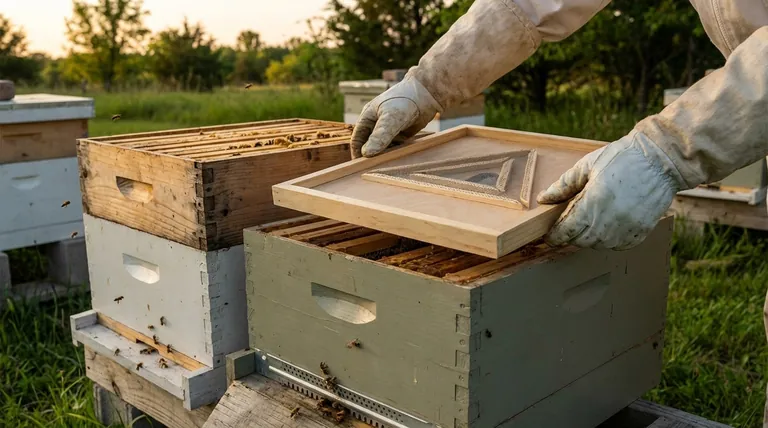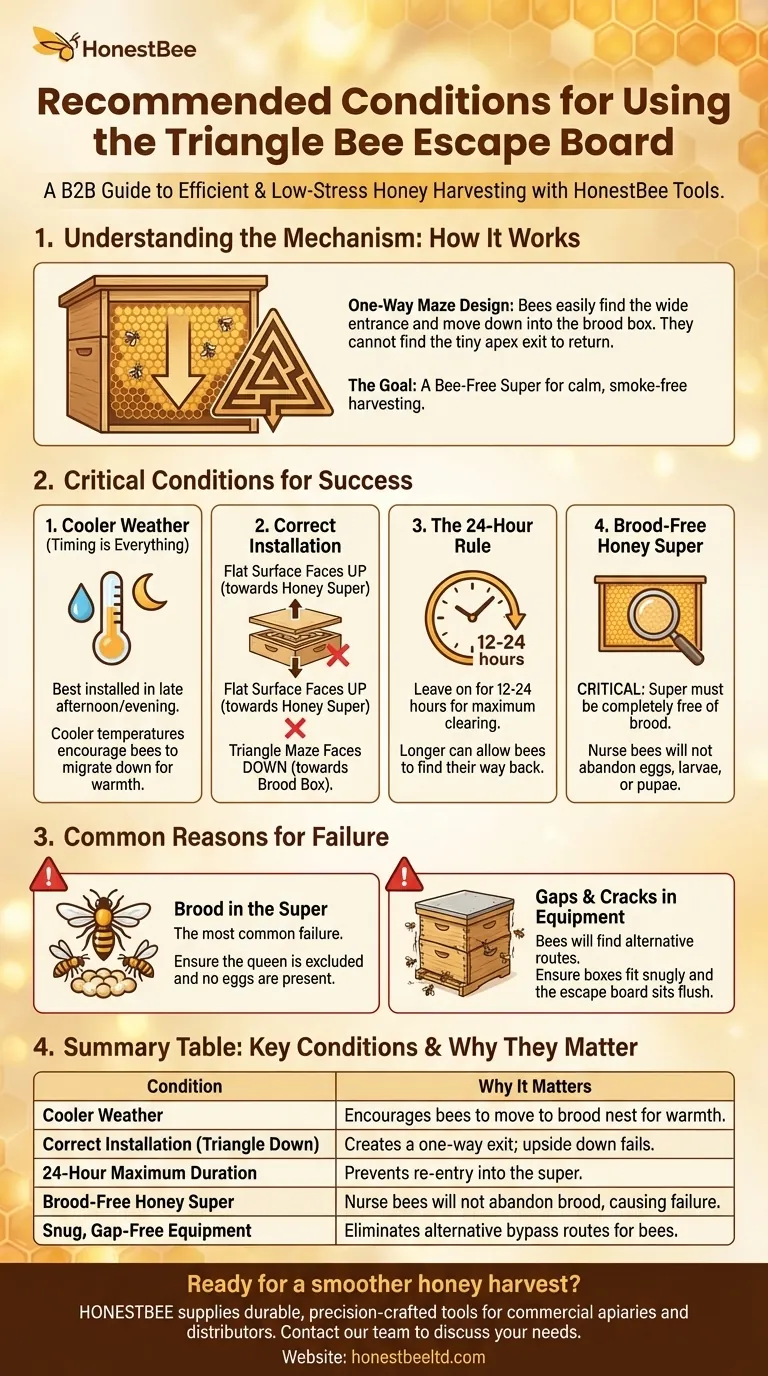For a triangle bee escape to work effectively, it must be used during cooler weather, installed correctly between the honey super and brood box, and left on for no more than 24 hours. Most importantly, the super you intend to clear must be completely free of any brood, otherwise the bees caring for it will not leave.
The triangle bee escape is a passive, low-stress tool for clearing bees from honey supers, but its success depends entirely on timing, proper installation, and understanding bee behavior. Using it incorrectly will result in a frustratingly full super and wasted time.

Understanding the Mechanism: How the Triangle Escape Works
A bee escape is a simple but ingenious device designed to clear bees from a honey super before you harvest it. Its effectiveness comes from exploiting the natural navigational tendencies of honeybees.
The One-Way Maze Design
The board contains a small, triangle-shaped maze. Bees in the honey super can easily find the wide opening of the triangle and move downward into the brood box below.
Once in the brood box, it is extremely difficult for them to find the tiny apex opening of the triangle to travel back up. This creates a gentle, one-way exit that empties the super over time.
The Goal: A Bee-Free Super
The purpose of this tool is to provide a calm, straightforward harvest. By removing the bees ahead of time, you can lift off a nearly empty super without the need for smoke or brushing, which reduces stress for both the beekeeper and the colony.
Critical Conditions for Success
To achieve a nearly bee-free super, you must align your actions with the environmental conditions and the internal state of the hive.
Timing is Everything: Use Cooler Temperatures
The ideal time to use a bee escape is during cooler weather, such as an overnight period. As temperatures drop, bees naturally migrate downward to cluster in the main brood nest for warmth.
Installing the escape board in the late afternoon or evening capitalizes on this instinct, encouraging a faster and more complete exodus from the honey super.
Proper Installation: Triangle Faces Down
This is a non-negotiable rule. The escape board must be placed with the flat surface facing up (towards the honey super) and the triangle maze structure facing down (towards the brood box).
If installed upside down, the "escape" becomes an easy entrance, and you will find your honey super just as full of bees as when you started.
The 24-Hour Rule
A bee escape should be left on the hive for approximately 12 to 24 hours. This gives the vast majority of bees ample time to move down into the brood chamber.
Leaving it on for longer than 24 hours is counterproductive. Resourceful bees may eventually discover cracks in the equipment or even figure out the maze, allowing them to re-enter the super.
Understanding the Trade-offs and Why Escapes Fail
A bee escape is not a foolproof tool. Its failure is almost always due to overlooking a key aspect of bee biology or having faulty equipment.
The Problem of Brood in the Super
This is the single most common reason for failure. Nurse bees will not abandon brood (eggs, larvae, or pupae).
If the queen has managed to get into the honey super and lay eggs, the nurse bees attending to that brood will stay put. The escape will fail to clear the super. Always check for brood before installing an escape board.
Gaps and Cracks in Equipment
The bee escape must be the only path between the super and the brood box. If your hive bodies are old, warped, or have cracks and gaps, the bees will simply use those as alternative routes.
Before installation, ensure your boxes fit together snugly and that the escape board sits flush, creating a proper seal.
A Few Stragglers Remain
Even under perfect conditions, you should not expect a 100% empty super. A few stray bees or newly emerged foragers may remain. Always wear your protective gear when removing the supers, just in case.
A Practical Checklist for Using Your Bee Escape
To ensure a successful clearing of your honey supers, follow this goal-oriented approach.
- If your primary focus is a fast, low-stress harvest: Install the escape in the late afternoon or evening when temperatures begin to cool, and plan to harvest the super the very next morning.
- If your primary focus is minimizing bee mortality: Always check your honey supers for any sign of brood before placing the escape board; this prevents trapping and stressing nurse bees.
- If your primary focus is ensuring complete clearing: Before installation, inspect your hive boxes for cracks or gaps and ensure the escape board sits flush, leaving no alternative entrances for the bees.
By aligning your use of the bee escape with the natural behavior of your colony, you can achieve a calm and efficient honey harvest.
Summary Table:
| Key Condition | Why It Matters |
|---|---|
| Cooler Weather | Encourages bees to move down into the brood nest for warmth. |
| Correct Installation (Triangle Facing Down) | Creates a one-way exit; upside down installation fails. |
| 24-Hour Maximum Duration | Prevents bees from finding their way back into the super. |
| Brood-Free Honey Super | Nurse bees will not abandon brood, causing the escape to fail. |
| Snug, Gap-Free Equipment | Eliminates alternative routes for bees to bypass the escape. |
Ready for a smoother, more efficient honey harvest?
HONESTBEE supplies commercial apiaries and beekeeping equipment distributors with the durable, precision-crafted tools needed for success. Our wholesale-focused operations ensure you get reliable equipment that performs when it counts.
Contact our team today to discuss your apiary's needs and discover how our beekeeping supplies can enhance your operation.
Visual Guide

Related Products
- HONESTBEE Wooden Bee Escape Board with Triangle Mesh Design for Beekeeping
- High-Efficiency Diamond Maze Bee Escape for Clearing Supers
- HONESTBEE Multi Exit Plastic Bee Escape Board for Efficient Honey Harvesting
- Circular Labyrinth Bee Escape for Efficient Hive Management
- Efficient Hive Clearing: HONESTBEE 8-Way Plastic Bee Escape
People Also Ask
- How is the Triangle Bee Escape Board placed when removing a super? Master the Correct Placement for a Stress-Free Harvest
- What is the effectiveness of the Bee Escape Board? Achieve a Calm, 95% Bee-Free Honey Harvest
- Where should the triangle escape board be placed in the hive? Master a Gentle, Stress-Free Honey Harvest
- What types of bee escape boards are available? Clear Your Supers Fast and Stress-Free
- What precautions should be taken when using the triangle escape board? Master Gentle Honey Harvesting



















